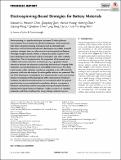Electrospinning‐Based Strategies for Battery Materials
Author(s)
Li, Xiaoyan; Chen, Weichen; Qian, Qingrong; Huang, Haitao; Chen, Yuming; Wang, Ziqiang; Chen, Qinghua; Yang, Jing; Li, Ju; Mai, Yiu-Wing; ... Show more Show less
DownloadAccepted version (4.599Mb)
Open Access Policy
Open Access Policy
Creative Commons Attribution-Noncommercial-Share Alike
Terms of use
Metadata
Show full item recordAbstract
© 2020 WILEY-VCH Verlag GmbH & Co. KGaA, Weinheim Electrospinning is a popular technique to prepare 1D tubular/fibrous nanomaterials that assemble into 2D/3D architectures. When combined with other material processing techniques such as chemical vapor deposition and hydrothermal treatment, electrospinning enables powerful synthesis strategies that can tailor structural and compositional features of energy storage materials. Herein, a simple description is given of the basic electrospinning technique and its combination with other synthetic approaches. Then its employment in the preparation of frameworks and scaffolds with various functions is introduced, e.g., a graphitic tubular network to enhance the electronic conductivity and structural integrity of the electrodes. Current developments in 3D scaffold structures as a host for Li metal anodes, sulfur cathodes, membrane separators, or as a 3D matrix for polymeric solid-state electrolytes for rechargeable batteries are presented. The use of 1D electrospun nanomaterials as a nanoreactor for in situ transmission electron microscopy (TEM) observations of the mechanisms of materials synthesis and electrochemical reactions is summarized, which has gained popularity due to easy mechanical manipulation, electron transparency, electronic conductivity, and the easy prepositioning of complex chemical ingredients by liquid-solution processing. Finally, an outlook on industrial production and future challenges for energy storage materials is given.
Date issued
2021Department
Massachusetts Institute of Technology. Department of Nuclear Science and Engineering; Massachusetts Institute of Technology. Department of Materials Science and EngineeringJournal
Advanced Energy Materials
Publisher
Wiley